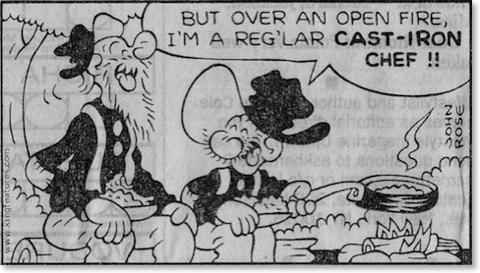Bacon Cooked in a Cast Iron Skillet
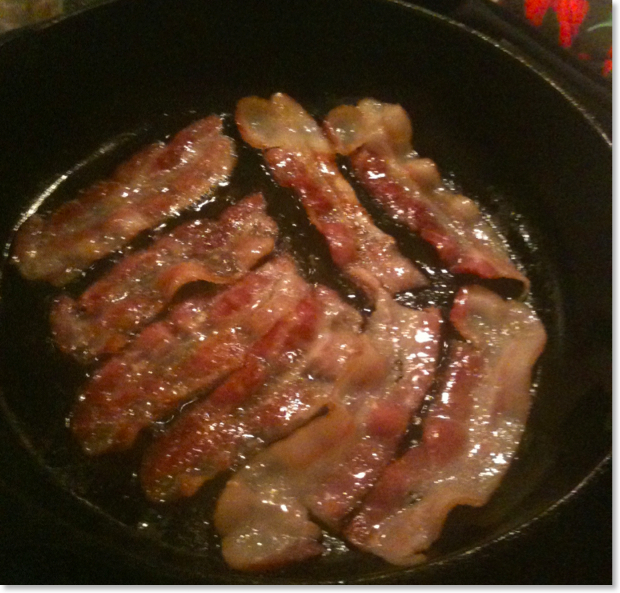
Tip #1: Cut the slices of bacon in half. My mom taught me this trick. She, like I, sometimes became frustrated when bacon slices curled on the ends and as a result cooked unevenly. A friend of Mom’s told her about cutting the bacon slices in two to make them lie flatter in the skillet. Well, it works like a charm! The bacon cooks more quickly and more evenly than full slices.

Tip #2: Use a cast iron press. My husband taught me this trick. I must admit that I don’t use the press as often as he does (frankly I forget), but it certainly makes the bacon lay flat and cook evenly. Even when following Tip #1 above, an occasional slice will curl slightly, depending on the brand. That’s where the cast iron press comes in handy. Rick uses the press on sausage patties, too.
Cast iron pictured above:
Feel free to leave your thoughts in the comments below, or you can contact Kathy directly at kathy@cookingincastiron.com.
Recent Cast Iron Acquisitions

Last month, Kathy and I took a day trip to Tennessee, and while we were in Sevierville made the required stop for any cast iron aficionado at the Lodge Cast Iron Outlet Store. This is the second time we had been to a Lodge outlet store, with the previous visit made to the store in South Pittsburg, where Lodge is headquartered. If you’re into cast iron like us (and if you’re reading this, you probably are), you know that visiting one of these stores is akin to a religious experience.

As we went along, spending about an hour in the store, Kathy and I walked up and down every aisle, making certain we had missed nothing. We called a family member as well as a friend of the family asking them if they needed us to get them anything while we were there. They both enthusiastically gave us their “orders.” Some of the items we picked up were novelties such as a Lodge baseball cap. It’s black with the Lodge logo on the front and the words “1896 * USA” on the back. I also got one of those rust eraser sticks I’d heard about, but have not had a chance to use. I’ve got a couple of old cast iron chicken fryers that need cleaning up. I’ll be certain to write about my results with the eraser when I’ve had a chance to try it out.


I’d also been wanting a lid for our cast iron wok for quite a while. I realize you may be thinking that a lid is not customarily used with a wok, and I’d have to agree with you completely. But let me explain why I wanted one.


A few months back, I emailed customer service at Lodge asking them if they made a lid for the wok. They do not, which didn’t surprise me. However, I was told that the 14” camping dutch oven lid fits perfectly. So, while in the store, I found one of these rather large lids and carried it over to a display where a few woks were sitting. I set the lid on top of the wok, and I was delighted to see that it fits perfectly! It’s almost as if the lid was especially designed for the wok.

What you see here is almost every piece of cast iron we own. Other than what you see here, I also have my main cast iron skillet that has a permanent place on the stove top. It the first cast iron piece I got back in the nineties. It is a Lodge 10.25" skillet that I received back before they began adding the extra grip handle and before everything came pre-seasoned.
I also have Kathy’s grandmother’s chicken fryers (two) in the back room waiting for me to find the time to clean them up and get them back into normal use. I don’t yet know what brand they are, but I look forward to trying to figure that out. My only other not-pictured cast iron item is a Wagnerware cornstick pan which I will have to take that rust eraser to before I can re-season it and get it back into working order.
Finally, pictured below are a few shots of the same rack above, but slightly enlarged so that you can see some of the items we have. I’m not showing these items to show off. I know of many cast iron collectors whose inventories are larger than ours. However, I also know that true cast iron aficionados enjoy looking at other folks’ cast iron. So, enjoy and feel free to post any questions or comments in the comment selection of this post.



Feel free to leave your thoughts or ask questions in the comments below, or you can contact Rick directly at rick@cookingincastiron.com.
Smothered Cooking in Cast Iron (Louisiana Cookin' - February, 2010)
I’m very pleased to announce that the current (Feb. 2010) issue of Louisiana Cookin’ contains an article I wrote, “Smothered Cooking in Cast Iron.” The article discusses the history and method of smothered cooking, and I also included five recipes written by myself, family, and friends.
Recipes included:
- Pointe Coupee Smothered Potatoes
- Uncle Larry’s Smothered Deer Steak
- Smothered Chicken and Andouille Sausage
- Hamburger Steak
- Queenie’s Smothered Steak
The article begins on p. 28 and concludes on p. 33. As you can see below, there are a number of very professional photographs of my recipes that accompany the article:

The February issue of Louisiana Cookin’ is now on sale at most major national book chains. If you’re visiting our website for the first time because you discovered us in Louisiana Cookin’, we hope you’ll come back regularly and visit us.
Feel free to leave your thoughts or ask questions in the comments below, or you can contact Rick directly at rick@cookingincastiron.com.
Regarding the New FTC Guidelines Regarding Endorsements, Testimonials

I want to let the readers here know that I think it's a great idea. You should know up front when you're reading a review of a product, book, movie, or whatever, whether or not the reviewer has been compensated in some way--even if it's stimply a free sample or copy of the product under review.
We've only offerered a handful of these kinds of reviews in this site's short tenure, but we've stated up front, every time, when a product was given to us. Last year, a chicken fryer was given to us for review, and after we reviewed it, we gave it away. We've reviewed a couple of food products (one coming up in a day or two), and we always acknowledge this as well.
My belief is that you want to know what we think of particular products or you wouldn't come here. I don't want you to think that we're biased just because someone sends it to us, though. If it's a food product, obviously we can’t send that back. But if it's something more tangible such as a piece of cast iron, we will always either give it away or send it back afterwards. If that policy were to ever change, I'd let you know. But with the roughly 30 or so pieces of cast iron that I cook with, not one of them has been given to me by a commercial company.
I also promise that if there's ever a product that we really don't like, we'll simply tell it like it is. If it's a product that's been sent to us.... well, this is simply the risk that companies take with reviews. But we'll always be very polite, of course!
We're also open to suggestions. If you'd like to see a particular product reviewed, let us know. If it's within our budget or if we can get a review copy/sample/demo from the manufacturer, we'll be glad to give it a shot.
And if you're a company that would like to see a product reviewed here, contact me at the email address below, and we'll consider it.
Feel free to leave your thoughts or ask questions in the comments below, or you can contact Rick directly at rick@cookingincastiron.com.
Recent Cast Iron Acquisitions
I’m not sure how much heavy cast iron affects Santa Claus’ gas mileage on his sleigh, but Kathy and I were very excited to receive a number of new cast iron cookware items for Christmas.

First up is a Lodge Sizzlin’ Chef Platter. My mother-in-law gave me this. I often complain that food gets cold on my plate too quickly. This will be the remedy.
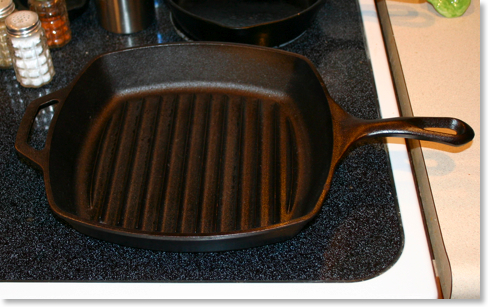
Kathy bought me this Lodge Square Grill Pan. You may have seen this in the pictures of the cast iron on our baker’s rack in an earlier post. Kathy bought it early, but wouldn’t let me use it until Christmas! It will be perfect for steaks this winter when I don’t want to cook outside in the cold on our Sportsman's Grill
.
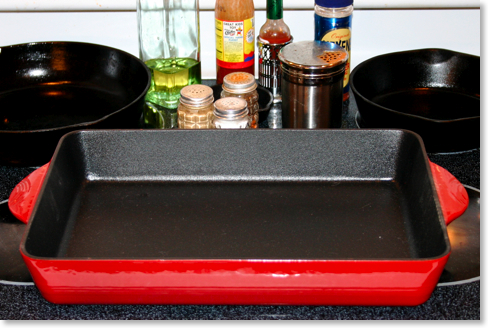
I’ve been wondering for a long time how some of our classic casseroles would cook in cast iron. I’ve experimented with good results using both our skillets and our dutch ovens, but I wanted something more to the size of a traditional casserole pan. Mom gave us this Lodge Color Enamel 4 1/4 Quart Roaster and I can’t wait to use it. However, at thirteen pounds and even heavier when full, using this pan will be a real workout!
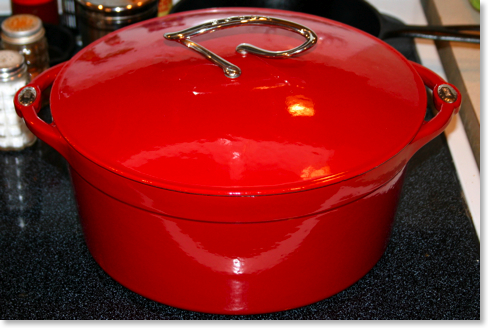
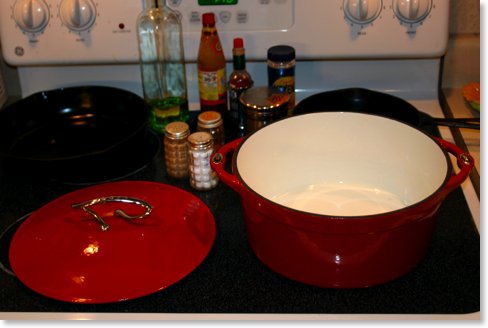
The two pictures above show off our new Lodge Enamel 5 qt. Dutch Oven. This will be our first enameled cast iron piece and perfect for foods that traditionally are hard on a cast iron pan’s seasoning, such as chili.
We’re very excited to add to our cast iron cookware. I’m sure you will see these items in pictures of upcoming recipes that we post online. What about you? Did you receive any cast iron recently or for Christmas? Let us know in the comments.
Feel free to leave your thoughts or ask questions in the comments below, or you can contact Rick directly at rick@cookingincastiron.com.
Showing Off the Iron
Where, oh where, do I store all of this cast iron? That is certainly the question that has plagued our household over the past year. We’ve owned various cast iron pieces over the past years, but after a trip to the Lodge Store in South Pittsburgh, Tennessee, we faced the dilemma of where to put the 17 new pieces of cast iron!

Rick and I already had a wrought iron baker’s rack from Ashley Furniture that showcased our cookbook collection, so we decided a matching baker’s rack would be the perfect partner piece to display our cast iron cookware. Although some assembly was required (by Rick, not me!), we are quite pleased with our new means of highlighting our cast iron in our home.

As you can see in the pictures, our heaviest pieces (dutch ovens) are on the bottom rack. We have smaller pieces such as fajita pans and loaf pans on the middle two shelves. The top shelf is reserved for cookbooks specific to cast iron aficionados. I was even able to find wrought iron book holders at Wal-Mart to help spotlight our favorite cookbooks.

Will another baker’s rack be in our future? Well, one more trip to Lodge just might do it!

Feel free to leave your thoughts in the comments below, or you can contact Kathy directly at kathy@cookingincastiron.com.
Apologies for the Hiatus
We have a number of great articles in the pipeline, so please continue to come back and check in with us.
Green Iron: The Environmental Benefits of Cast Iron Cookware

Perhaps you’ve never thought about it. I mean, most folks who have been cast iron aficianados for a while are familiar with the other benefits. Of course there are healthy benefits to cast iron. Cooking in cast iron is a great way to introduce trace amounts of iron into one’s diet. Plus, there’s no flaking Teflon to worry about getting into one’s food. Then, on another front, there are economical benefits to cast iron because these pans--except for the enameled variety--cost MUCH less than other kinds of cookware.
Bur you may or may not have ever thought about the environmental benefits of cast iron. These benefits can be divided into at least three main areas: (1) Toxicity (or lack thereof), (2) production, and (3) longevity and recyclability.
First, as mentioned above in regard to health, cast iron cookware is a smart alternative to Teflon-coated aluminum pans. According to the Environmental Working Group website,
Statistics reported by the Cookware Manufacturers Association indicate that 90 percent of all the aluminum cookware sold in the United States in 2001 was coated with non-stick chemicals like Teflon (Cooks Illustrated, September 2002). Chemicals and tiny, toxic Teflon particles released from heated Teflon kill household pet birds. At least four of these chemicals never break down in the environment, and some are widely found in human blood.
This is obviously not a concern with cast iron cookware which builds its non-stick surface naturally through the carbonization process of heating oils and fats on the cooking surface. What about the cast iron that comes pre-seasoned--is that coating harmful? Not at all. Pre-seasoning is nothing more than vegetable oil (and it’s Kosher vegetable oil if you get a Lodge pan!) heated at high temperatures. Yes, it can flake off, but it won’t hurt human beings or animals and this vegetable oil coating is fully biodegradable.


Since cast iron, if treated well, gets better with age, my grandmother’s skillet actually has a greater non-stick surface than the skillet I got brand new in the nineties. Certainly, the cast iron in the pan itself can be recycled, but the best way to recycle a pan is to pass it on down to a family member. I fully intend that my grandmother’s pan will outlast me, and I’ll be able to pass it down to my children or grandchildren.
Consider this as well: because cast iron is a lifetime investment (and a low-cost one at that!), you won’t have to completely replace your pans every decade or so as some people have to do with cookware made of other materials.
So, if you’ve been sitting on the fence in regard to whether or not you should make the jump to cast iron, now you have even more reasons to do so. And if you already use cast iron, you can feel good about the fact that cast iron is a smart, economical purchase, is healthy for you and your family, and is friendly to the environment as well. That cannot be said of any other kind of cookware.
Feel free to leave your thoughts in the comments below, or you can contact Rick directly at rick@cookingincastiron.com.
Cast Iron Accessories



No, I don't sell Pampered Chef, but I sure am pleased with the great products I've discovered through that company to help keep our cast iron looking fabulous in every season!
Feel free to leave your thoughts in the comments below, or you can contact Kathy directly at kathy@cookingincastiron.com.
Welcome to Cooking in Cast Iron

Cast Iron Is Hot (Pun Intended)
We’ve now come full circle. Everywhere I go--whether a neighbor’s kitchen, the gourmet kitchen store, or a campfire in the woods--I’m seeing more and more cast iron. Now, even celebrity chefs have their names on their own lines of cast iron. But it wasn’t always that way. In spite of the fact that cooking in cast iron was the only way for most people to prepare meals for centuries, cast iron began to fall on hard times in the 1940’s with the development of modern artificial nonstick surfaces. And so in recent years, cast iron went into a kind of teflon-inspired exile. If you wanted to find a good cast iron pan, often you had to visit the hardware or sporting goods store (in the camping section, no less) or simply resort to mail order.
But of course, great cooks such as your grandmother who would have never dreamed of giving up her cast iron skillet or Uncle Ted who can’t imagine camping without his dutch ovens have remained true to the black iron. So, they aren’t surprised when recent studies tell us that those artificial non-stick coatings may not be so safe and healthy afterall. And suddenly lots of folks are starting to come back to cast iron.
A Cast Iron Renaissance
I believe we’re in a bit of a “cast iron renaissance.” I began to see signs of this two and a half years ago when Mark Bittman published an interesting article in the New York Times, titled “Ever So Humble, Cast Iron Outshines the Fancy Pans.” In the article, Bittman traces his own journey through twenty years in which after using more modern cooking surfaces, he had returned to an old standby: cast iron--in both his own cooking and in regard to what he recommends. And he’s not alone; suddenly there is lots of talk in the food industry about cooking in cast iron.
So what brought about this return? Well, perhaps a number of things, not the least of which is the sudden concern over chemically-based nonstick pans already mentioned above. But years ago, those modern pans also brought a seemingly bad rap for cast iron. The new pans were marketed as being much easier to use and care for than cast iron. And there was probably some truth to that. In the past, when buying a cast iron pan, the pan had to be “seasoned”; that is, you had to add a cooked on layer of oil or fat to the pan before it could be used. Plus, you had to be very careful how cast iron pans are cleaned. You can’t just throw them in the dishwasher like the “fancy pans.” And as people began to eat out more often, the lessons from the previous generations about how to care for cast iron were less frequently passed down to the next.

I still think I can do the seasoning process better myself, but I’ve come to peace with pre-seasoning which I’ll write about at a later date. What’s important for right now, however, is that pre-seasoned pans have allowed cooks who were previously intimidated by cast iron to come back to the basics. That, and inflating fuel prices, which give way to higher food costs are allowing smart consumers to cook for themselves more often than perhaps in previous years. The family meal is making a comeback, and we’re discoving that the pilgrims, pioneers, and grandma had it right: cast iron is best for preparing almost any meal.
A Black Iron Romance
If you cook with cast iron long enough, it slowly wins you over. There’s something attractive about cast iron; it has its own culinary kind of seduction. I reach for a cast iron pan first now. If I don’t have something I need for cooking, I look to see if there’s a cast iron variety of whatever it is. I now even grill on the back patio completely on cast iron.

I can pick up a cast iron skillet or a dutch oven, and I know that I hold in my hands a quality instrument that, baring great clumsiness on my part, will certainly outlast me. If the house burns, I can grab my family members, the pets, and the picture albums if time allows. The cast iron can be retrieved after the fire because it’s that tough. In the event of apocalypse, we can still cook in cast iron! Cast iron is solid, and its weight when I hold it in my hand says to me that it will still be with me when I come to the end of my days, waiting to be passed on to the next generation.
Striking While the Iron Is Hot
So why this website? Well, I and my other contributors consider ourselves “cast iron advocates.” As stated in our purpose statement, our goal is “to promote the use of cast iron cookware across all spectrums of culinary pursuits--from the gourmet kitchen to the old fashioned campfire and everything in between. Our goal is to both educate and advocate cooking in cast iron.” There are a lot of great cooking/culinary-related websites out there, and there are also quite a few sites that talk about the use and care of cast iron. We hope to provide something a bit unique by offering new articles every few days about the use and care of cast iron. Our goal is not meant to simply be informative in our primary posts, but to be personal as well.
Some of our contributions will come in the form of news, interviews and reviews. We will also post informative/how-to articles. Our goal is to create a monthly video podcast devoted entirely to cooking in cast iron--something that I haven’t found anywhere else. We’re setting up the home page of this site in the form of a blog, but it’s so much more than a blog. Nevertheless, you will be able to interact with the writers and other cast iron users through the comment system.
And perhaps you even have an idea for which you might want to submit free-lance style yourself. We’re not set up to pay for submissions yet, but we hope to be there one day. Regardless, we welcome your ideas now.
We hope that you will bookmark cookingincastiron.com, subscribe to our RSS feed and/or check back here often. Whether you’ve been cooking in cast iron all your life or have a skillet rusting at the bottom of your pantry, we believe that we have something to offer you, and you have something to offer us.
Come back and check for new posts soon.
Feel free to leave your thoughts in the comments below, or you can contact Rick directly at rick@cookingincastiron.com.








